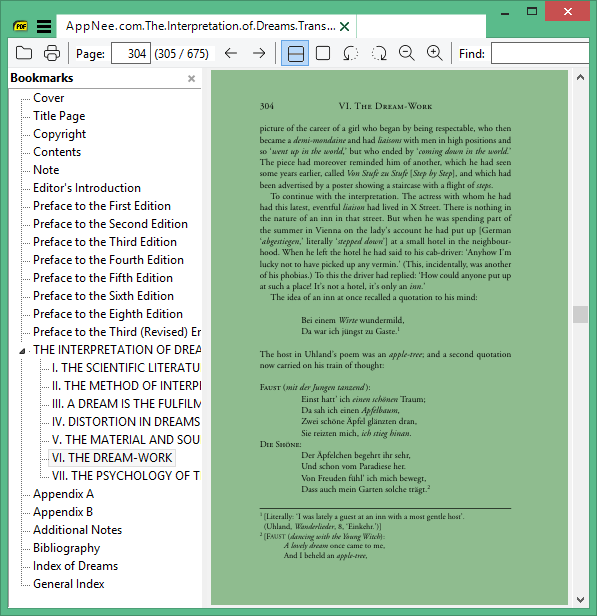
The Interpretation of Dreams (AKA: Die Traumdeutung) is a seminal work in psychology first published in 1899, written by Sigmund Freud, an Austrian neurologist and the founder of psychoanalysis. This book pioneered Freud's theory of "dream interpretation," which is described as a shortcut to "understanding subconscious psychological processes" by him. He claimed to have discovered three major truths: dreams are the disguised satisfaction of unconscious desires and childhood desires; the Oedipus complex is a common human psychological emotion; and children have sexual awareness and motivation.
This pioneering book explores the complex realm of dreams and their significance in understanding the human psyche. Freud's central thesis suggests that dreams are a manifestation of our unconscious desires, fears, and repressed thoughts. He believed that by analyzing and interpreting dream symbols, one could gain insight into their hidden conflicts and unresolved issues. For example, Freud examined the recurring dream of a patient where they were flying freely through the sky. Through his interpretation, he concluded that this dream symbolized the individual's desire for freedom and liberation from their current circumstances.
Moreover, Freud introduced the concept of the "dreamwork," which describes the process by which the unconscious mind disguises its true meaning through symbolism and condensation. He argued that dreams carry latent content, representing the hidden underlying thoughts, emotions, or memories, which are then transformed into manifest content, the actual images and events experienced in the dream. By deciphering these symbols and exploring their connections to an individual's personal experiences and traumas, Freud illuminated the potential for self-discovery and psychological healing.
The Interpretation of Dreams has had a profound impact on the field of psychology, providing a framework for understanding the unconscious mind and its influence on human behavior. It sparked further research and debate, inspiring the development of various psychoanalytic theories and therapeutic practices. While some aspects of Freud's ideas have been criticized or challenged, his emphasis on the significance of dreams in unraveling the complexities of the mind remains a valuable contribution. Overall, this influential work continues to captivate and stimulate discussions about the mysterious realm of dreams and the subconscious.

Table Of Contents
- Preface to the First Edition
- Preface to the Second Edition
- Preface to the Third Edition
- Preface to the Fourth Edition
- Preface to the Fifth Edition
- Preface to the Sixth Edition
- Preface to the Eighth Edition
- Preface to the Third (Revised) English Edition
- THE INTERPRETATION OF DREAMS
- I. THE SCIENTIFIC LITERATURE DEALING WITH THE PROBLEMS OF DREAMS
- II. THE METHOD OF INTERPRETING DREAMS: AN ANALYSIS OF A SPECIMEN DREAM
- III. A DREAM IS THE FULFILMENT OF A WISH
- IV. DISTORTION IN DREAMS
- V. THE MATERIAL AND SOURCES OF DREAMS
- VI. THE DREAM-WORK
- VII. THE PSYCHOLOGY OF THE DREAM-PROCESSES
- Appendix A
- Appendix B
- Additional Notes
- Bibliography
Download URLs
| License | Format | Download | Size |
| Original | |||
| Free book |  |
28.2 MB | |
| Translated and Edited by James Strachey | |||
| Free book |  |
2.54 MB | |